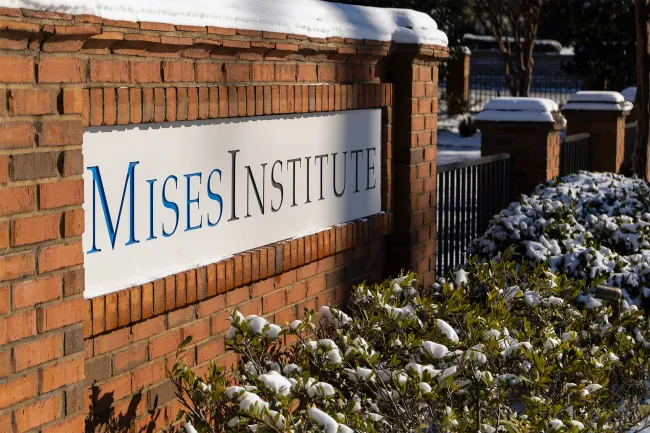For more than 80 years—since the days of the New Deal—the US federal government has embarked on a wide variety of policies that were ostensibly intended to increase the homeownership rate. The underlying idea—a rather dubious one, at that—has always been that homeownership is a proxy for economic prosperity.
It’s debatable whether or not such reforms have ever actually worked to increase the homeownership rate, though. In 1930, at the very beginning of the Great Depression, the homeownership rate was 44 percent. During the thirties, the federal government adopted policies that created Fannie Mae and ushered in the era of the 30-year fixed mortgage.
Homeownership subsequently increased substantially after the end of the Second World War, and this continued into the 1960s with the homeownership rate reaching nearly 65 percent in 1970.
[Read More: “Are Today’s Homeownership Rates Sustainable?“ by Ryan McMaken]
It’s unclear whether this was fueled by any government policy or if it was a result of the US’s rapid post-war expansion during that period. Moreover, rising homeownership levels were likely influenced by the fact that the average marrying age fell after the War and stayed unusually low during the fifties and sixties.
Whatever the cause, the homeownership rate rose to 65.5 percent in 1980, and has never returned to pre-war levels below 60 percent.
Since 1980, however, the homeownership rate in the United States has gone approximately nowhere. According to the Census Bureau’s most recent quarterly estimate on the homeownership level in the United States, the homeownership rate during the first quarter of 2025 was 65.2 percent. That’s down from the fourth quarter of last year when the homeownership rate was 65.7 percent. The first quarter’s rate is also down from the first quarter of last year when the rate was also 65.7 percent.

Source: US Census Bureau.
Yes, there was sizable growth in the homeownership rate during the housing bubble from 2002-2006, but that all collapsed in the ruins of Great Recession and the post-2007 foreclosure glut.
So, in 2025, the homeownership rate is almost exactly where it was 45 years ago, in 1980. This is the current reality in spite of the fact that the average 30-year mortgage rate has collapsed from 18 percent in 1981 to less than seven percent in 2025. This has acted as a de facto subsidy for home prices, since lower mortgage rates allows sellers to raise asking prices for homes. Thus, home prices move opposite mortgage rates, so we see that falling mortgage rates have simply led to higher home prices, and not to more affordable homes. This is reflected in the fact that affordability in home prices is the lowest its been in decades, and the average age of home buyers has surged.

Source: US Census Bureau, Federal Reserve Board of Governors
Politically, however, the central bank’s efforts to force down interest rates—which has required monetary inflation—has been justified on the grounds that it “increases homeownership.” Moreover, Federal policymakers since 2008 doubled down on subsidizing home purchases with the bailouts of Fannie Mae and Freddie Mac in 2008.
Yet, none of this has produced more affordable homes. It has only led to price inflation. This has been great for Wall Street and those who already own assets. It’s been a disaster for younger people and first-time home buyers.
In his column last week, Alex Pollock summarized the problem, and offers a solution:
What has the massive US government intervention in mortgage lending achieved in the way of improved home ownership? The US home ownership rate was about 64 percent in 1970 and it is 65 percent in 2025. It has hardly increased in 55 years, all the government and government-sponsored housing finance notwithstanding.
The government intervention has, however, helped inflate two 21st century house price bubbles. The first peaked in 2006 and led to the financial crisis of 2007-09. The second sent average house prices far above their 2006 peak, including rising at over 18 percent in 2021. This has led to their continuing unaffordable levels, especially for young families trying to buy their first house. Although the rate of increase has now become moderate, average house prices are still rising, at the annualized rate of 3 percent in April 2025. With inflation at 2.3 percent for that month, average house prices are also still going up in real terms.
It is often observed that US house prices are simply too high, which helps explain why sales of existing houses in 2024 were the fewest since 1995, even though the population is 27 percent larger than then.
We can conclude that the vast scale of US government intervention in guaranteeing and subsidizing of mortgage debt has been a mistake. The housing finance system should grow more private, with the market share of the GSEs being systematically reduced and the government’s overall role getting smaller. The Federal Reserve’s target for investment in mortgages should be zero. The government should target a substantial reduction in the percentage of the mortgage market it guarantees. As a first estimate, I recommend a reduction to 20 percent, down from the current egregious 70 percent.
Now is the time to admit that easy-money policy and corporate bailouts—imposed in the name of increasing homeownership—has only made housing more unaffordable.


